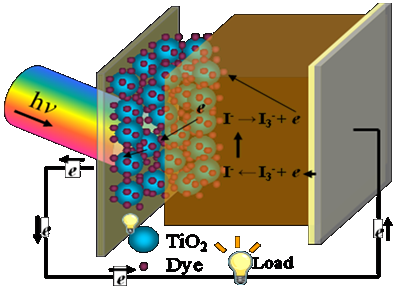|
· Porous Metal Oxide Thin Films for Dye-Sensitized Solar Cell
The worldwide fossil energy crisis has brought much attention to the pursuit of alternative energy sources. Solar energy is one of the most abundant and green energy supplies. Dye-sensitized solar cell (DSSC) is a low cost photovoltaic device based on an organic sensitizer attached on a porous metal oxide semiconductor followed by an iodide/tri-iodide contained polymer electrolyte and a counter electrode. Figure 1 shows the schematic illustration of DSSC architect and working function. Electrons in dye molecules are excited by sun light incident through the front window. The excited charges inject into TiO2 anode electrode then go outside circuit and reach counter electrode. The electronic charges are transferred to tri-iodide to yield iodide that reduces dye molecule to its original state.
Different than traditional and expensive Si-based or p-n junction thin film solar cells, DSSC takes advantages of the high surface area of mesoporous thin films for harboring the light sensitizers.2 Porous titanium dioxide has been demonstrated to be the most efficient material to incorporate with dye molecules. This project focuses on the fabrication through a sol-gel method with the assistance of polymer templates as structure directing agents to generate porous structures with pore size ranging from a few to hundreds nanometers. The integrated solar cells are subject to characterization of the photo-electrical energy conversion efficiency using a semiconducting measurement system with an illumination of sun light simulator. Another goal of this project is the development of new polymer ionic electrolytes with high conductivity and excellent mechanical strength. The polymer gel electrolytes are qualified to fabricate solid state DSSCs and superior to liquid electrolytes in leakage concern. The highly stable and reliable polymer electrolyte potentially improves solar cell quality.
|

|
Figure 1. Schematic illustration of dye-sensitized solar cell. Blue balls are TiO2 nanoparticles attaching dye molecules as purple dots. Redox couple contained polymer electrolyte provides electrons to neutralize excited dye molecules. |
